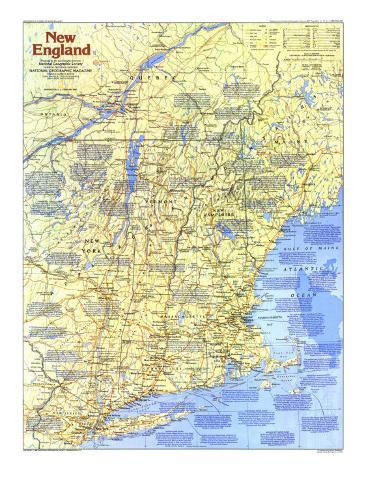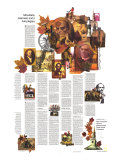PROVINCETOWN - In November 1620 the Mayflower anchored. Before moving on to Plymouth, the Pilgrims drew up the Mayflower Compact, the basis of the constitution of the Commonwealth of Massachusetts. Descendants of Portuguese fishermen from the Azores, and Lisbon now constitute a majority of the year-round residents. This summer resort has gained renown as a colony for artists, writers, and musicians.
THE BERKSHIRES - During the late 1800s wealthy families – including the Vanderbilts and Carnegies – built mansions in the Stockbridge, Lenox, and other villages in the Berkshires. A century later the well-to-do still find these hills an agreeable summer retreat, as do crowds of day visitors and aficionados of art, drama, and music. Tanglewood host the Berkshire Music Festival.
CAPE COD - The summer tourist influx to this beach-fringed peninsula brings in about one billion dollars. Between 1970 and 1980 Cape Cod's year-round population grew by more than 50 percent ot 170,000. A building boom worries many longtime residents, who cite lax zoning laws and lack of long-range planning for roads and water supply. Many shellfishing sites have been closed because of municipal pollution.
DEERFIELD - Outposts such as Deerfiled, Massachusetts, were hard hit during the war led by Wampahoag Indian King Philip in 1675-76. In subsequent bouts of warfare, with time-outs for uneasy peace, the French and their Indian allies harried English frontier villages. Deerfield was devastated again in 1702; the French and Indians killed 49 townspeople.
GLOUCESTER - “They that go down to the sea in ships.” The inscription on Leonard Craske's bronze statue of a fisherman speaks for generations of Glouscester mariners. Since the seaport's founding in 1623, 10,000 Glousestermen have died in the fog-blanketed, shoal-ridden waters of the Grand Banks. In the mid-1700s Gloucester shipbuilders developed the schooner, renowned for its seaworthiness. Today this city, an outlier of Boston, still relies on fishing and fish processing, but the summer catch of tourists is also important.
LEXINGTON-CONCORD - In the early 1770s Lexington's patriots pledged to “be ready to sacrifice our estates and everything dear in life, yes, and life inself” for American independence. In the first encounterof the Revolutionary War, on April 18, 1775, British troops routed the rebels at Lexington, but the Americans won the day at Concord. In the 1800s Concord becme famous for its literary figures, including Ralph Waldo Emerson, Nathaniel Hawthorn, Louisa May Alcott, and Henry David Thoreau.
LOWELL - Francis Cabot Lowell brought British cloth-weaving methods to the Chelmsford area, which offered water power and ample room to grow. in 1820, three years after Lowell's death, his Boston Assocites established new England's first company town. A historic part re-creates the textile era, when Yankee girls from country villages worked in Lowell's mills. High-tech and other electronics industries hold promise for the future.
MASSACHUSETTS COLLEGE TOWNS - Amherst contains Amherst Colleg, founded in 1821 to educate young men for the Christian ministry, and the 26,000-student University of Massachusetts, which opened in 1863 as Massachusetts Agricultural College. Close by is Hampshire College, an experimental-curriculum liberal arts institution chartered in 1965. Sophia Smith's goal in establishing Smith College in 1871 was to turn out “the intelligent gentlewoman.” In South Hadley the nation's earliest women's college, Mount Holyoke, admitted its first students in 1837. Today, under a special plan, students at any of these five colleges can attend courses at all of them.
SALEM - Puritans from Cape Ann founded Salem in 1626. The town earned a notorious place in history with its witch trials. By the early 1800s merchants in this leading port were so wealthy that Oriental trade partners imagined the city to be a sovereign nation. Salem preserves fine examples of colonial, Georgian, and federal architecture.
SPRINGFIELD - Puritans settled the rich bottomlands of the Connecticut Valley in 1636. During the Revolutionary War craftsmen made gun and ammunition for the American cause, and in 1794 the U.S. government built the Springfield Armory. Until its closure in 1968 the armory pioneered in the production of firearms, from the flintlock musket to the M14. The sport of basketball originated here.
STOCKBRIDGE - In 1734 whites came to live in this mission settlement as “civiliing examples” to the Mahicans. Despite fighting for U.S. independence, the Mahicans were forced out of Stockbridge in the early 1800s by the rising tide of white settlers. Illustrator Norman Rockwell worked here until his death in 1978.
FALL RIVER - Endowed with a good harbor, potential for water power, and a moist climate that favors cotton spinning, Fall River enjoyed a century-long textile boom beginning in the 1820s. Competition from the Deep South and a devastating fire pushed Fall River into bankruptcy during the Great Depression. Diversified manufacturing keeps it solvent today.
WORCESTER - The second largest city in Massachusetts has long been a seedbed of technological innovation. Worcester inventors produced the power-planing machine, the leather-heeling machine, and various carpet looms. in the 1950s Worcester medical reserchers developed the birth-control pill.
NEWPORT - Puritan dissents from Boston lead by William Coddington and John Clarke, a Baptist, founded Newport in 1839. A hub of shipbuilding and maritime commerce, the town grew opulent from the slave trade. Its days as a summer resort began in the mid-1800s. A naval center today, Newport also hosts a jazz festival and has been the site of the America's Cup sailing races.
WOONSOCKET - By the mid-1800s the swiftly flowing Blackstone River and its tirbutaries powered the most heavily industrialized region in the U.S. The Blackstone Canal, a financially unsuccessful bid by Providence to enlarge its orbit, opened in 1828 to Worcester, Massachusetts, stimulating textile towns such as Woonsocket, Rhode Island.
PROVIDENCE - “Having of a sense of God's merciful provindence unto me,” Puritan rebel Roger Williams founded a farming colony on this spacious harbor in 1636. During the American Revolution, Providence served as a gateway to Boston, and in the late 1700s sailed ahead of its maritime rival, Newport. Tool and textile manufacturing and the making of fine jewelry became important in the early 1800s.












